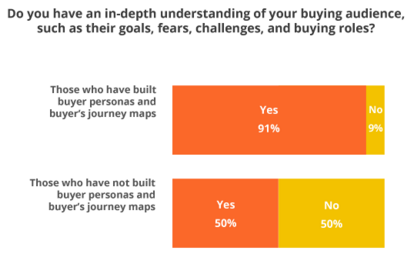Buyer personas have the potential to dramatically transform your content marketing strategy. Considering they’ve been found to make online campaigns two to five times more effective, it’s no surprise buyer personas are becoming more common tools for B2B and B2C marketing teams. The process of creating buyer personas involves research and planning for the best possible outcome, making it essential to approach it tactfully.
What is a buyer persona?
A buyer persona is a profile of the typical customer. It includes a name and photo of this hypothetical person as well as their personal details as they relate to your interaction with them. Sounds simple, right? Well, it actually takes a substantial amount of work to develop these profiles, as there are many details to incorporate to create a complete picture.
For B2B personas, this will include details like:
- Their role in the company hierarchy as well as the purchase process.
- Experience in their industry and current position.
- Fears and concerns regarding their jobs and your potential role.
- Knowledge of what you are offering.
For B2C personas, this will include details like:
- Basic demographics (age, gender, education level, etc.).
- Hobbies and interests.
- Personal goals and motivators.
- Personality traits.
If you don’t already have personas in place, the idea of creating them can seem daunting at best. After all, you need to determine who your most typical buyers are and how many personas your team should have. Beyond that, figuring out the details of each persona requires a lot more than playing a game of Guess Who?

Playing the long game with personas
“Patience, you must learn patience.” – Yoda
Creating buyer personas is not as easy as filling out a questionnaire and calling it a day. It takes detailed research, preparation and thought to develop each persona, and it’s rare that you’ll need only one persona.
You won’t have a tangible product to put to use right away. Considering how much work can go into creating personas, and the benefits you’ll find once they’re finished, the delayed gratification may feel discouraging.
Having patience during the developmental stages is a must, as the end result will be well worth the effort and the wait.

The hidden benefits of persona creation: The process will also be illuminating for those involved. Akoonu, a strategic buyer-centric marketing provider, found that 91 percent of companies with buyer personas have a deep understand their audience. Among those who don’t have personas? Only half felt confident in their knowledge of their audience.
Understanding your potential customers gives you the ability to produce content that is exactly what they’re looking for. As you begin to build out your persona profiles, you will also begin to see your site, services and content through their eyes.
You will inherently shift your approach to better cater to your personas as you build these profiles. When you’re answering their questions, allaying their fears and providing information they need to make a decision before they even reach out to you, you will only improve the chances of converting them to sales.
The daunting task of getting started
Just as a blank page can cause a writer to freeze up, the first stage of the buyer persona may seem monumentally intimidating. The development process has a few layers that must be tackled one by one.
You need to conduct some initial research, ideally from internal and external resources, to develop a clearer picture of the different personas you need to build. Once you know which personas you want to pursue, you’ll gather more data, analyze it and sift through to find the most common attributes to create thorough persona profiles for each. On paper, it is straightforward, but the nuances of developing the appropriate questions to ask in the research stage, and actually collecting and compiling feedback requires more time and effort than filling in the blanks.
Prepare for the hurdles you may encounter by exploring these two common pain points that crop up when creating buyer personas:
Pain Point No. 1: Defining your personas
You have a pretty good idea of who your target audience is, but your ideal customer may not perfectly align with reality. You could make an educated guess regarding the most likely personas, but if you’re going to put in the work to create them, why not start out with the most accurate information you can get? Buyer personas allow you to get even closer to the heart of your customers, and uncovering the most realistic ones will allow you to reap the most rewards in the end.
The best place to start digging up the true personas is your sales department. Their goal is to understand the ins and outs of their prospects so they can close deals. They can help you separate the wheat from the chaff and eliminate all but the most essential personas based on the types of people they encounter most often.
But, internal feedback is only one piece of the puzzle. A salesperson’s perspective of the customers is inherently different than how customers see themselves, so go direct to the source as well. Send out a short survey to a sample of your current and prospective clients to get some initial information (you’ll want more detailed feedback later on). Ask questions salespeople won’t be able to answer, such as what the customer’s fears and personal goals are and how they view your company compared to competitors.
Create some overlap in the questions you ask internal and external respondents to ensure accuracy:
Potential questions for B2B personas
- What is their position at company? (decision maker, influencer, etc)
- How are they involved in the buying process?
- What is their knowledge of your product/service/industry?
Potential questions for B2C personas
- What do they do for work?
- What is their education level?
- What are their interests?
Their responses, along with your internal feedback, should allow you to create visual maps of data that will reveal the best personas to explore.
Pain Point No. 2: The interview process
This stage of persona development can be divided into three subsets: developing buyer persona questions, conducting interviews and analyzing the results.
To learn more about who your personas really are, you need to go back to your sales team and reach out beyond your company to your customers (present and future). The initial interviews were short and easy, because you only had to find out the framework of the personas. But now, you need to build them out to get as much information as you can.
What questions do you ask?
Creating a list of interview questions can be challenging. You don’t want to miss something essential to the persona, but you also don’t want to wind up with needless data. A good way to get the ball rolling is to take a creative break and focus first on choosing a name and picture for each persona. Not only does this allow you to have some fun, but it lets you begin to see your personas as “real” people.
Although you’ll be asking both your internal teams and your customers these questions, you can make the process of question creation easier by developing them with the buyer in mind. When you present the questions to your teams, ask them to step inside the minds of their clients, and be sure to reinforce the persona type throughout the process to keep the feedback on track.
Overall, you want to learn what makes each persona tick. Some questions may not be as relevant to internal respondents as others, such as those regarding personal information. Your coworkers will be able to provide more insight into the personas as they relate to your business, and the external questionnaire can focus more on the opinion-based questions.
How do you conduct the interviews?
You have a few options for gathering information at this stage. You can meet with people in person, conduct surveys over the phone or send out digital surveys. The one-on-one element is always going to be the most informative, as you can ask followup questions and clarify answers immediately. However, unless you have a lot of bandwidth to interview nearly every client-facing member of your company, you’ll only be able to get data from a handful of people with in-person interviews.
Creating surveys that allow people to answer questions in their own time can increase the number of responses you’ll get back. To bring in more external responses, consider offering a downloadable asset like an eBook as an incentive to take the survey. For online surveys, multiple choice questions will make sorting through data easier at the end, but open-ended questions allow for the possibility of answers you didn’t consider. Choose the most appropriate option for every question.
Ideally, a combination of interviews and surveys will provide a good array of feedback. Interviews can give you deeper insight, while surveys allow you to reach a wider swath of respondents.
How do you sift through the responses?
After you get a healthy amount of responses, it’s time to start parsing the information. This can be time consuming whether you have 10 or 1,000 responses. Find the overlap in the responses to each question. Data analysis is an inherently manual task when you’re working with interviews, and the more responses you have the longer it will take. Yet, it is also the most crucial to capture the sharpest snapshot of who each persona truly is.
Walk through each interview question one more time and find the most common answers. This is where digital surveys will be your friend, especially for questions that were presented in multiple-choice form. You can quickly see which answers stand out, leaving more time to sort through the open-ended questions. Grab a cup of coffee and gather your team together to go through the longer responses together. More heads are better than one in spotting patterns and trends among the feedback.
To create the most accurate – and subsequently the most beneficial – personas, you need to get in the trenches and do the dirty work. There really are no shortcuts, unless you count opting for multiple choice interview questions over open-ended, in the developmental stages. Persona building will not always move quickly because it requires a lot of nurturing the grow the best result. If you’re going to take the time to invest in personas, go all in to get as big of a return as possible.
Read more about the benefits of buyer personas:




